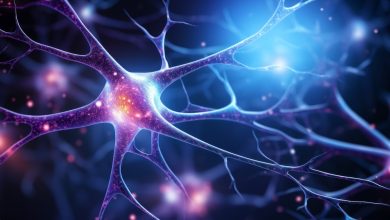Gene Therapy Slows ALS Progression

Summary: Researchers have made a significant advance in the treatment of ALS using a new gene therapy, marking a notable slowing of disease progression in a patient with an aggressive form of ALS. The patient, treated since early 2020, has retained much of his physical and social abilities, exceeding typical life expectancy and functionality projections for his condition.
This therapy targets the SOD1 gene mutation, thereby reducing levels of a harmful protein and stabilizing the patient’s condition. The results offer hope for future advances in the treatment of ALS and broader applications of gene therapy.
Highlights:
- Effective gene therapy: The therapy significantly reduces levels of the ALS-related protein SOD1, thereby slowing the progression of the disease.
- Remarkable result for patients: Four years after diagnosis, the patient continues to perform daily activities independently, a rare feat for people with aggressive ALS.
- FDA and EMA approvals: The drug has been approved by the FDA and recommended by the EMA for use in patients with SOD1 gene mutations, indicating its effectiveness and potential.
Source: Umeå University
There has been a breakthrough in research into the disease amyotrophic lateral sclerosis (ALS).
Scientists at Umeå University report that disease progression in a patient with a particularly aggressive form of ALS has slowed significantly thanks to the use of a new gene therapy.
After four years of treatment, the patient can still walk up stairs, get out of a chair, eat and talk well, and lead an active, socially fulfilling life.
“I consider this to be a major step forward for the research we have been carrying out for over 30 years, here at Umeå University and the University Hospital of Northern Sweden. We have never seen treatment results as effective as these, with any other treatment,” says Peter Andersen, neurologist and professor at the Department of Clinical Sciences at Umeå University.
“An important finding is that it is now possible to significantly reduce the levels of the disease-causing SOD1 protein, while measuring a clear inhibitory effect on subsequent disease progression.
“When we diagnosed the patient in the neurology department in early spring 2020, the patient’s prognosis was at best 1.5 to 2 years of survival. The patient far exceeded his expectations.
The patient comes from a family in southern Sweden with a particularly aggressive form of ALS caused by a mutation in the SOD1 gene. When a loved one was diagnosed with ALS, the patient left a blood sample for research with the ALS research team at Umeå University, but chose not to know the results genetic testing.
However, the patient carried the gene for the disease, and after experiencing muscle weakness four years ago, he realized he had it too. The patient was immediately seen by the medical team at the University Hospital of Northern Sweden and diagnosed with ALS at an early stage.
Since summer 2020, the patient has been participating in the phase III study evaluating a new gene therapy developed for patients with SOD1 mutations causing misfolding and aggregation of the SOD1 protein in motor neurons.
Every four weeks, the patient received the experimental treatment at a university hospital in Copenhagen, Denmark.
Biomarker reduced by almost 90%
At the time of diagnosis in 2020, levels of neurofilament L, a biomarker indicating nerve cell breakdown, were very high in the patient. Now, four years later, levels have fallen by almost 90%.
“When the patient was diagnosed at the University Hospital of Northern Sweden in April 2020, we measured the level of neurofilament L up to 11,000 nanograms per liter, which is high even for an ALS patient.
“In the most recent sample, after 50 injections of the new drug, the level fell to between 1,200 and 1,290, which represents a substantial decrease in the disease indicator,” explains Peter Andersen.
“The normal level for someone in the patient’s age group is less than 560. In the blood, the neurofilament level returned to normal levels and was down to 12 at the last hospital visit. The normal level is less than 13.”
The patient’s functional level, measured using the ALSFRSR scale, is reduced compared to a healthy individual (48 points) but has remained almost at the same level, around 35 to 37 points, over the last 18 months. , meaning that the patient’s functional level is reduced by approximately 26% compared to a healthy individual.
A person with this aggressive type of ALS genetic mutation that the patient has typically loses 1 to 1.5 points each month. This means that without treatment, the expected progression of the disease would have been very rapid and would have resulted in significant disability within 6 to 12 months and would most likely have led to the patient’s death in 2021.
“That this patient, more or less unhindered, can still climb stairs four years after the onset of the disease is something of a miracle to see,” says Karin Forsberg, a neurologist and researcher in the Department of Clinical Sciences who has worked alongside Peter Andersen and has been researching SOD1 and ALS for over two decades.
“To successfully complete a drug treatment in this way is a great achievement and a source of inspiration. But that by no means means the work is done. This is just the beginning.
“It should also be remembered that the drug in question does not constitute a curative treatment, but it seems capable of slowing the progression of the disease. This gives us great hope for developing more pharmaceutical treatments for ALS patients.
There are many types of ALS, and only 2 to 6 percent of them have ALS caused by a mutation in the SOD1 gene. Many have a familial form of the disease, but SOD1 mutations have also been found in so-called sporadic cases of ALS.
“It is currently unknown whether this drug has a similar effect on other types of ALS. Much more research is needed on the subject,” says Peter Andersen.
The patient can still do almost everything he could do when he first joined the study in summer 2020: his speech is not affected and he manages to do everything himself, he mows the lawn, runs errands and takes care of his body. children. Mentally, he also feels much better, mainly because he now dares to feel hope.
‘This is just the beginning’
The study in which the patient is participating ends this summer. The drug is not yet available in Sweden, but it has been approved by the US Food and Drug Administration, FDA, and on February 23, 2024, the European Medicines Agency, EMA, recommended its use in patients carrying the SOD1 gene. changes within the European Union.
However, the Council for New Therapies of Sweden has asked regional healthcare providers not to prescribe the drug until a health economic assessment has been provided by the Dental and Pharmaceutical Benefits Agency.
“Our next step is to study the outcomes of patients receiving this drug. It worked for some, but not everyone saw the same positive effect. This may be a matter of dosage or the stage of the disease at which treatment was initiated.
“Maybe additional medications are needed to stop the process completely? These are questions that we must now try to answer. This is just the beginning,” says Karin Forsberg.
She imagines a future in which treatment will be administered based on the type of ALS the patient has and will most likely require a combination of medications.
She points out that a lot of research is being carried out in Sweden and abroad to find new drug targets so that equivalent drugs can be developed for groups of patients with other types of ALS, and she hopes this will come true.
“We can measure in the samples taken from the patient that the disease process is ongoing, but that the patient’s body seems able to compensate. Even now, four years after the patient started taking this new gene therapy drug.
The Swedish Ethical Review Authority approved participation in these studies and now, several years later, we, together with ALS doctors from other participating countries, are seeing a clear clinical effect on many treated patients,” says Peter Andersen .
“The next step will be to obtain approval from the Swedish Ethical Review Authority to study the compensatory mechanisms that treatment with this drug appears to have activated. This could be an opportunity to better understand how previously unknown parts of the nervous system work and to develop new, even better drugs.
About this ALS and gene therapy research news
Author: Peter Andersen
Source: Umeå University
Contact: Peter Andersen – Umeå University
Image: Image is credited to Neuroscience News
Original research: The results will appear in eLife.
News Source : neurosciencenews.com
Gn Health





